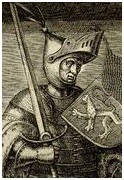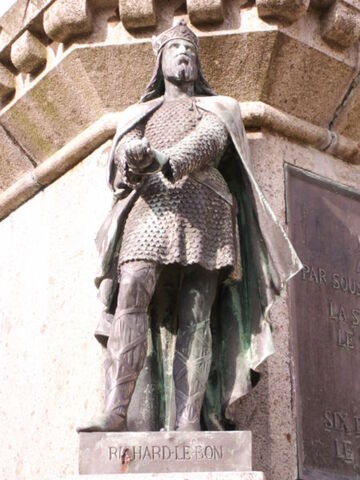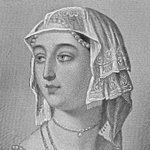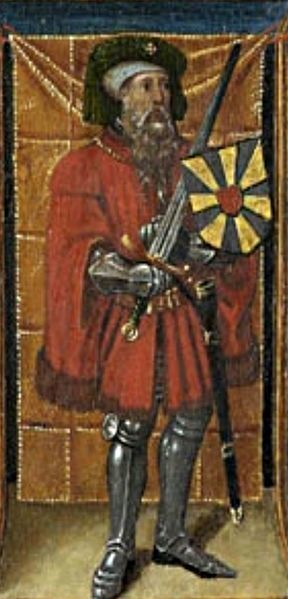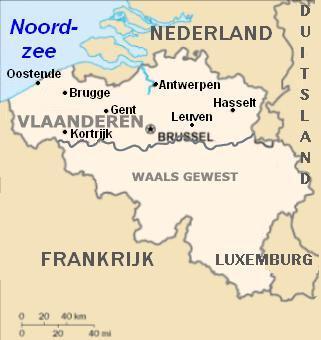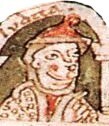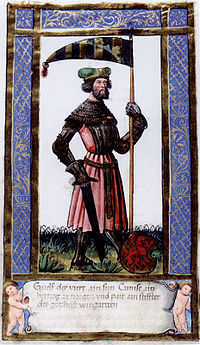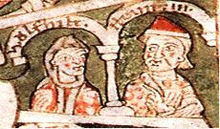maximum test » Judith "Judith van Vloandern" of Flanders (1033-1094)
Persoonlijke gegevens Judith "Judith van Vloandern" of Flanders
- Roepnaam is Judith van Vloandern.
- Zij is geboren in het jaar 1033Nord-Pas-de-Calais France.
- Beroepen:
- Grevinne av Flandern.
- Grevinne av Flandern.
- grevinne.
- (Misc Event) .
- (Misc Event) .
- Zij is overleden op 4 maart 1094, zij was toen 61 jaar oudWeingarten
Baden-Wurttemberg Duitsland. - Zij is begraven in het jaar 1094Weingarten
Baden-Württemberg Duitsland. - Een kind van Baldwin en Eleanore Richardsdatter von Normandie
- Deze gegevens zijn voor het laatst bijgewerkt op 23 mei 2018.
Gezin van Judith "Judith van Vloandern" of Flanders
Zij is getrouwd met Welf.
Zij zijn getrouwd in het jaar 1071, zij was toen 38 jaar oudBavaria Duitsland.
Kind(eren):
Notities over Judith "Judith van Vloandern" of Flanders
Name Prefix:Countess Name Suffix: of Flanders
Grevinne av Flandern. Født fra 1028 til 1033. Død 05.03.1094.
Judith var grevinne av Flandern.
I henhold til Erich Brandenburgs ?Die Nachkommen Karls des Grossen? skulle hun ca. 1071 igjen være blitt gift med Welf I (IV) av Bayern. Dungern mener derimot i ?Thronfolgerecht und Blutsverwandscaft der Deutschen Kaiser seit Karl dem Grossen? at Welf var gift med en datter av henne med samme navn.
Hennes far, Balduin IV av Flandern, var første gang gift ca. 1012 med Otgiva av Luxemburg (995 - 1031). Han var annen gang gift etter 1031 med Eleonore(?) av Normandie, født ca. 1010. Hun var datter til Richard II ?den Gode? avNormandie som døde 23.08.1027 og Judith av Bretagne (ca. 982 - 1017).
Judith skal være født i 1028 eller 1033, hvilket gjør at det er usikkert hvem som var hennes mor.
Judith var grevinne av Flandern.
I henhold til Erich Brandenburgs ?Die Nachkommen Karls des Grossen? skulle hun ca.
1071 igjen være blitt gift med Welf I (IV) av Bayern. Dungern mener derimot i ?Thronfolgerecht
und Blutsverwandscaft der Deutschen Kaiser seit Karl dem Grossen? at Welf var gift med en
datter av henne med samme navn.
Hennes far, Balduin IV av Flandern, var første gang gift ca. 1012 med Otgiva av
Luxemburg (995 - 1031). Han var annen gang gift etter 1031 med Eleonore(?) av Normandie,
født ca. 1010. Hun var datter til Richard II ?den Gode? av Normandie som døde
23.08.1027 og Judith av Bretagne (ca. 982 - 1017).
Judith skal være født i 1028 eller 1033, hvilket gjør at det er usikkert hvem som var
hennes mor.
[alfred_descendants10gen_fromrootsweb_bartont.FTW]
"(not dau of Baldwin V). (Brandenburg). Weis 166-23.
Various sources disagree regarding Judith's specific ancestry. Some s uggest that she was a daughter of Baldwin IV of Flanders, by his 2nd w ife, a princess of Normandy. Others suggest that she was a daughter o f Baldwin V of Flanders, and some say she was a daughter of Richard II I of Normandy. Frederick Weis in Ancestral Roots ( line 166, # 23 ) , suggests that she is the daughter of Baldwin IV, rather than of BALD WIN V, she married the Earl Tostig of Northumbria before marrying Welf .
#Générale#inhumation : Weingarten Allemagne
#Générale#D'autres sources pensent qu'elle serait fille
de Richard III de Normandie et d'Adélaïde de France,
ce qui en fait de toute façon la petite-fille de Richard II.
{geni:about_me}
https://de.wikipedia.org/wiki/Judith_von_Flandern
'''Judith van Vlaanderen, de Flandre, of Flanders.''' Daughter of Baudouin IV 'le Barbu' & Eleonor (his second wife)
Married to:
1. Tostig Godwinsson
2. Welf
JUDITH de Flandre ([1033]-5 Mar 1094, bur St Martin Monastery). The Annalista Saxo names "Iudhita…amita Rodberti comitis de Flandria ex cognatione beati Ethmundi regis" as husband of "Haroldi" (in error for Tostig) but correctly names her second husband "Welphus filius Azzonis marchionis Italorum"[206].
The Genealogia Welforum names "filiam comitis Flandrie, reginam Anglie, Iuditam nomine" as wife of Welf[207]. Florence of Worcester says that Judith was "daughter of Baldwin Count of Flanders" but does not specify which Count Baldwin, nor is this clear from the context[208]. According to the Vita Ædwardi Regis, Judith was the sister of Count Baudouin V[209]. On the other hand, Alberic de Trois Fontaines asserts that Judith was one of the children of Baudouin V Count of Flanders and his wife Adela de France[210], but there are other clear errors in Alberic's listing of this couple's children so the statement should be viewed with caution.
Judith is also listed as the daughter of Count Baudouin V (after Mathilde) in a manuscript whose attribution to Orderic Vitalis is disputed, which also shows her first marriage[211]. The date of her first marriage is confirmed bythe Anglo-Saxon Chronicle which records that she fled with her husband and parents-in-law after the Council of 9 Sep 1051[212]. Judith moved to Denmark after her first husband was killed. The Chronicon of Bernold records the death "1094 IV Non Mar" of "Iuditha uxor ducis Welfonis Baioariæ" and her burial "apud monasterium…Sancti Martini" built by her husband[213].
The necrology of Raitenbuch records the death "III Non Mar" of "Iudinta regina Anglie, filia marchionis de Este uxor Welfonis nostri fundatoris"[214], exaggerating her status resulting from her first marriage and confusing her paternity. The necrology of Weingarten records the death "III Non Mar" of "Judita dux regina Anglie"[215], also exaggerating her status resulting from her first marriage.
Judith Fausta van Vlaanderen (1031/1035 - 5 maart 1094) was een dochter van graaf Boudewijn IV van Vlaanderen en van (vermoedelijk) zijn tweede echtgenote Eleonora van Normandië. Zij was in 1051 gehuwd met Tostig Godwinsson, graafvan Northumberland, en in 1071 met Welf IV, hertog van Beieren (overleden 1101). Zij was de moeder van:
* Skuli Tostisson Kongsfostre (*1052)
* Ketil Tostisson
* Welf V (1072-1120)
* Hendrik de Zwarte (1075-1126)
* Kunizza (-1120), die huwde met graaf Frederik Rocho van Diessen.
In 1067 erfde Judith van Boudewijn V van Vlaanderen een kostbare relikwie, die volgens de legende een met aarde vermengde bloeddruppel van Jezus bevatte. De bloeddruppel zou opgevangen zijn door een Romeinse soldaat , later bekendworden als de H. Longinus . Samen met zijn gebeente kwam de relikwie naar Mantua en Boudewijn V kreeg de relikwie in 1056 van keizer Hendrik III. Bij haar dood in 1094 liet Judith de relikwie na aan de abdij Weingarten.
-----------------------------
Judith (Fausta) von Flandern (* um 1030; † 5. März 1094, begraben im Kloster Weingarten in der Familiengruft der Welfen) stammte aus dem Hause der Markgrafen von Flandern. Sie war Gräfin von Northumbria (in erster Ehe mit Tostig Godwinson) und Herzogin von Bayern (in zweiter Ehe mit Welf IV.).
Abstammung:
Die genaue Einordnung Judiths in die Folge flandrischer Eltern und Töchter ist unklar. Im wesentlichen finden sich drei konkurrierende Versionen:
1. Version
Judith wurde 1027/28 als Tochter von Richard III. von der Normandie und Adela von Frankreich geboren. Damit war Judith die Stieftochter von Balduin V. von Flandern, der Adela 1028 nach dem Tod Richards III. heiratete. Die Schätzung für das Geburtsjahr Judiths ergibt sich aus dem Todesdatum Richards III. (6. August 1027).
Diese Version ist jedoch zweifelhaft, da es sich bei der Verbindung zwischen Adela von Frankreich und Richard III. von der Normandie vermutlich nur um eine Verlobung handelte, die wegen des Todes Richards III. nicht mehr in die Ehe einmünden konnte. Über Kinder aus dieser Verbindung gibt es keine gesicherten Hinweise.
2. Version
Judith wurde um 1030 als Tochter von Balduin V. von Flandern und Adela von Frankreich geboren.
Die enge Verwandtschaft zwischen Balduin V. und dem Geschlecht der Welfen (über Balduins Mutter Otgiva von Luxemburg) wäre jedoch wahrscheinlich ein Hindernis für die spätere Heirat von Judith mit Welf IV. gewesen. Daher wird diese Version ebenfalls angezweifelt.
3. Version
Judith wurde 1031/32 als Tochter von Balduin IV. von Flandern und dessen zweiten Frau Eleonore von der Normandie, der Schwester von Richard III., geboren. Damit war Judith die Halbschwester von Balduin V. von Flandern, der aus derersten Ehe ihres Vaters mit Otgiva von Luxemburg stammte. Die Schätzung für das Geburtsjahr Judiths ergibt sich aus dem Jahr der Heirat zwischen Balduin IV. und Eleonore (ca. 1031).
Ehen und Nachkommen:
Judith von Flandern war in erster Ehe mit Tostig Godwinson, Graf (Earl) von Northumbria, verheiratet. Nach dessen Tod am 25. September 1066 in der Schlacht von Stamford Bridge heiratete sie 1070/71 Welf IV., der 1070 als Welf I. Herzog von Bayern wurde
Aus Judiths erster Ehe stammen vermutlich zwei Söhne:
* Skuli Tostisson Kongsfostre (* um 1052)
* Ketil Tostisson (* um 1054)
Aus Judiths zweiter Ehe gingen drei Kinder hervor:
* Welf V. (* 1072/73, † 24. September 1120 auf Burg Kaufering); er wurde nach dem Tod seines Vaters auf dem Kreuzzug 1101 als Welf II. Herzog von Bayern
* Heinrich der Schwarze (* 1074/75, † 13. Dezember 1126 in Ravensburg); er übernahm nach dem Tod seines Bruders 1120 als Heinrich IX. das Herzogtum Bayern
* Kunizza († 6. März 1120)
Judith von Flandern und die Heiligblut-Reliquie.
Im Jahre 1067 erbte Judith von Balduin V. eine kostbare Reliquie, die der Legende nach einen mit Erde vermischten Blutstropfen Jesu Christi enthält. Dieser Blutstropfen soll von einem römischen Legionär aufgefangen worden sein, der später als der Heilige Longinus bekannt wurde. Mit seinen Gebeinen war die Reliquie nach Mantua gekommen. Balduin V. hatte die Reliquie 1056 von Kaiser Heinrich III. erhalten.
Bei ihrem Tod 1094 vermachte Judith die Heiligblut-Reliquie zusammen mit wertvollen Handschriften der Abtei Weingarten, dem Hauskloster der Welfen. In Erinnerung daran findet bis heute am Freitag nach Christi Himmelfahrt, dem sogenannten Blutfreitag, in Weingarten der Blutritt statt - die größte Reiterprozession der Welt mit rund 3.000 Reitern in Frack und Zylinder, zahlreichen Musikkapellen und etwa 30.000 Pilgern und Zuschauern.
------------------
SKULI Tostesson "Kongsfostre", son of [TOSTIG Godwinsson & his wife Judith de Flandre] . Snorre names "Skule, a son of Earl Toste, who since has been called the king's foster-son, and his brother Ketil Krok…of high family in England" when recording that they accompanied Olav King of Norway after their father's were both killed at the battle of Stamford Bridge[214], the context suggesting that he and his brother were adults at the time. If this is correct, they must have been their father's illegitimate sons and not the children of Tostig who were “unweaned” when their father died, referred to in the Vita Ædwardi Regis[215]. Morkinskinna records that “Skúli, the son of Jarl Tostig Godwinson, and Ketill krókr from Hálogaland came to Norway with King Óláfr” after the failed invasion of England in 1066[216]. Snorre records that King Olav granted lands "eastward at Konungahella, Oslo, Tunsberg, Sarpsborg, Bergen, and north at Nidaros" to Skule[217]. Morkinskinna records that “not long after King Haraldr´s fall Skúli went west to England to ask for the return of King Haraldr´s body” which was “readily granted to him”[218].
--------------------
Eller er hennes mor Adele av Frankrike, f.ca.1009, Burgund, Frankrike, d.8.1.1079, Lille, Frankrike ? Se Aner for Bjørn Espell. og August og Liv Brenne ' s World.
Se på nettet: Bjørn Gustav Espell
(XXXXX@XXXX.XXX)-nygaard.com <(XXXXX@XXXX.XXX)-nygaard.com>
Biografi - Biography
Judith var grevinne av Flandern.
I henhold til Erich Brandenburgs «Die Nachkommen Karls des Grossen» skulle hun ca. 1071 igjen være blitt gift med Welf I (IV) av Bayern. Dungern mener derimot i «Thronfolgerecht und Blutsverwandscaft der Deutschen Kaiser seit Karldem Grossen» at Welf var gift med en datter av henne med samme navn.
Hennes far, Balduin IV av Flandern, var første gang gift ca. 1012 med Otgiva av Luxemburg (995 - 1031). Han var annen gang gift etter 1031 med Eleonore(?) av Normandie, født ca. 1010. Hun var datter til Richard II «den Gode» av Normandie som døde 23.08.1027 og Judith av Bretagne (ca. 982 - 1017).
Judith skal være født i 1028 eller 1033, hvilket gjør at det er usikkert hvem som var hennes mor. 1--------------------------------------------------------------------------------
1. Erich Brandenburg: Die Nachkommen Karls des Grossen, Leipzig 1935. C.M. Munthe: Norske slegtsmerker, NST Bind I (1928), side 345. Mogens Bugge: Våre forfedre, nr. 837. Bent og Vidar Billing
Hansen: Rosensverdslektens forfedre, side 37, 84.
She was the daughter of Boudewijn IV "met de Baard", Graaf van Vlaanderen and Otgiva von Lothringen.1,2,3 Judith de Normandie married Earl of Northumbria Tostig Godewinesson of Wessex, son of Godwin, Earl of Wessex and Gytha Thorkelsdóttir, circa 1045; Her 1st.8,5,2 Judith de Normandie married Welf I, Herzog von Bayern, son of Adalbert II, Markgraf von Mailand and Kunigunde, Erbin von Altdorf, in 1070; His 3rd. Her 2nd (widow).5 Judith de Normandie died on5 March 1094 at age 61 years.5 Judith de Normandie was buried in the foundation at Weingarten.
--------------------
Reference: http://www.lillebye.no/ane12.htm
--------------------
Judith of Flanders, Countess of Northumbria
From Wikipedia, the free encyclopedia
Judith of Flanders, Countess of Northumbria, and later Duchess of Bavaria (1033 – 5 March, 1094)[1], was the wife firstly of Tostig Godwinson, Earl of Northumbria, and secondly of Welf I, Duke of Bavaria. Her niece was Matilda of Flanders, Queen consort of William the Conqueror, who was Judith's cousin.
She was the owner of many books and illuminated manuscripts, which she bequeathed to Weingarten Abbey.
Family
Judith was born in 1033 in Bruges, the only child of Baldwin IV, Count of Flanders by his second wife, Eleanor of Normandy, who was herself, the daughter of Richard II of Normandy and Judith of Brittany. Judith had an older half-brother, Baldwin V, Count of Flanders, who succeeded their father upon his death which had occurred when Judith was about two years old. Judith's niece was Matilda of Flanders who married William, the first Norman king of England, known to history as "William the Conqueror". King William was Judith's first cousin, being the son of her maternal uncle, Robert of Normandy.
[edit]First Marriage
On an unknown date before September 1051, she married her first husband, Tostig Godwinson, brother of King Harold II of England. In September 1051, Judith was forced to flee England for Bruges, along with her husband and in-laws after Tostig joined his father's armed rebellion against King Edward the Confessor; however, they returned home the following year.
He was created Earl of Northumbria in 1055, making Judith the Countess of Northumbria, from that date onwards. His distinguished marriage to Judith had helped Tostig secure the earldom.[2]
Together they had children whose names and numbers are not recorded. They were described in the Vita Edwardi Regis as "unweaned" at the time of their father's death.[3] Tostig had at least three illegitimate sons by unknown mistresses.
Judith was described as having been a "pious and inquisitive woman"; her piety was expressed in the many gifts and donations she made to the Church of St. Cuthbert in Durham, which included landed estates and an ornate crucifix. The latter allegedly was a present to appease the saint after she challenged St. Cuthbert's ruling that forbade women to enter the cathedral which housed his relics. Judith, angered that women were not permitted to set foot inside the church and wishing to worship at his tomb, had decided to put Cuthbert's prohibition to the test by ordering her serving woman to go inside to see what repercussions would follow for breaking the holy decree (Judith had planned to go herself upon the latter's safe return); when the woman was about to enter the churchyard, she was stricken by a sudden, violent force of wind that left her infirm and eventually killed her. Judith, as a result of superstitious fear, had the crucifix especially made for St. Cuthbert's shrine.[4]Throughout her life, she collected and commissioned many books and illuminated manuscripts, some of which are extant,[5]including the Gospels of Countess Judith, which are currently housed in Pierpont Morgan Library in New York City. These were written and illuminated by English scribes and artists to record for posterity, Judith's generosity to the Church.
In October 1065, Northumbria rose in rebellion against the rule of Tostig. After his brother Harold persuaded King Edward to accept the demands made by the rebels, there was an acrimonious confrontation between the two brothers, with Tostig accusing Harold of fomenting the rebellion. In November, Tostig was outlawed by King Edward, and Judith, along with Tostig and her children, was compelled to seek refuge with her half-brother in Flanders the following month. Count Baldwin appointed Tostig as castellan of Saint-Omer.[6] In May 1066 following the succession of Harold to the English throne in January, he returned to England with a fleet provided by Baldwin to seek revenge on his brother. He formed an alliance with King Harold III of Norway, but they were both killed on 25 September 1066 at the Battle of Stamford Bridge by the forces of King Harold.
After her husband's death at Stamford Bridge, Judith moved to Denmark.[7]It is presumed that she brought her "unweaned" children with her to Denmark; however, nothing is known of their subsequent fates. Less than a month after Tostig's death, Judith's brother-in-law was killed at the Battle of Hastings by the Norman army led by her cousin, William the Conqueror, who would thereafter reign as William I of England.
[edit]Second marriage
In 1071, when she was 38 years of age, she married her second husband, Welf I, Duke of Bavaria, who had divorced his childless wife, Etherinde von Northeim in 1070. Upon her marriage, she became Duchess of Bavaria; however in 1077, her husband was deprived of his title, and did not regain it until 1096, two years after her death.
They made their principal home at the castle of Ravensburg and together had two sons,[8] and one daughter:
Welf II, Duke of Bavaria (1073- 24 September 1120), married Matilda of Tuscany, but the marriage did not produce issue.
Henry IX, Duke of Bavaria (1074- 13 December 1126), married Wulfhild of Saxony, by whom he had seven children.
Kunizza of Bavaria (died 6 March 1120), married Frederich Rocho, Count of Diesen
[edit]Death
Judith died on 5 March 1094 and was buried at St. Martin Monastery, the Benedictine abbey which had been built by Duke Welf on the Martinsberg in Weingarten, and had received Judith's patronage. She also had bequeathed her magnificent library and a relic of Christ's Blood to the abbey.[9] The Chronicon of Bernold recorded the death "1094 1V Non Mar of Iuditha uxor ducis Welfonis Baioariae" and her subsequent burial.[10]. Her husband Duke Welf died in 1101 in Cyprus while returning home from the First Crusade.
In fiction:
Judith appears as a character in Jean Plaidy's historical romance The Bastard King; however, she is incorrectly portrayed as Matilda of Flanders' sister.
Judith von Flandern und die Heiligblut-Reliquie [Bearbeiten]
Im Jahre 1067 erbte Judith von Balduin V. eine kostbare Reliquie, die der Legende nach einen mit Erde vermischten Blutstropfen Jesu Christi enthält. Dieser Blutstropfen soll von einem römischen Legionär aufgefangen worden sein, der später als der Heilige Longinus bekannt wurde. Mit seinen Gebeinen war die Reliquie nach Mantua gekommen. Balduin V. hatte die Reliquie 1056 von Kaiser Heinrich III. erhalten.
Bei ihrem Tod 1094 vermachte Judith die Heiligblut-Reliquie zusammen mit wertvollen Handschriften der Abtei Weingarten, dem Hauskloster der Welfen. In Erinnerung daran findet bis heute am Freitag nach Christi Himmelfahrt, dem sogenannten Blutfreitag, in Weingarten der Blutritt statt - die größte Reiterprozession der Welt mit rund 3.000 Reitern in Frack und Zylinder, zahlreichen Musikkapellen und etwa 30.000 Pilgern und Zuschauern.
Judith was born in 1033 in Bruges, the only child of Baldwin IV, Count of Flanders by his second wife, Eleanor of Normandy, who was herself, the daughter of Richard II of Normandy and Judith of Brittany. Judith had an older half-brother, Baldwin V, Count of Flanders, who succeeded their father upon his death which had occurred when Judith was about two years old. Judith's niece was Matilda of Flanders who married William, the first Norman king of England, known to history as "William the Conqueror". King William was Judith's first cousin, being the son of her maternal uncle, Robert of Normandy.
First Marriage
On an unknown date before September 1051, she married her first husband, Tostig Godwinson, brother of King Harold II of England. In September 1051, Judith was forced to flee England for Bruges, along with her husband and in-laws after Tostig joined his father's armed rebellion against King Edward the Confessor; however, they returned home the following year.
He was created Earl of Northumbria in 1055, making Judith the Countess of Northumbria, from that date onwards. His distinguished marriage to Judith had helped Tostig secure the earldom.
Together they had children whose names and numbers are not recorded. They were described in the Vita Edwardi Regis as "unweaned" at the time of their father's death. Tostig had at least three illegitimate sons by unknown mistresses.
Judith was described as having been a "pious and inquisitive woman"; her piety was expressed in the many gifts and donations she made to the Church of St. Cuthbert in Durham, which included landed estates and an ornate crucifix. The latter allegedly was a present to appease the saint after she challenged St. Cuthbert's ruling that forbade women to enter the cathedral which housed his relics. Judith, angered that women were not permitted to set foot inside the church and wishing to worship at his tomb, had decided to put Cuthbert's prohibition to the test by ordering her serving woman to go inside to see what repercussions would follow for breaking the holy decree (Judith had planned to go herself upon the latter's safe return); when the woman was about to enter the churchyard, she was stricken by a sudden, violent force of wind that left her infirm and eventually killed her. Judith, as a result of superstitious fear, had the crucifix especially made for St. Cuthbert's shrine.Throughout her life, she collected and commissioned many books and illuminated manuscripts, some of which are extant,[5]including the Gospels of Countess Judith, which are currently housed in Pierpont Morgan Library in New York City. These were written and illuminated by English scribes and artists to record for posterity, Judith's generosity to the Church.
In October 1065, Northumbria rose in rebellion against the rule of Tostig. After his brother Harold persuaded King Edward to accept the demands made by the rebels, there was an acrimonious confrontation between the two brothers, with Tostig accusing Harold of fomenting the rebellion. In November, Tostig was outlawed by King Edward, and Judith, along with Tostig and her children, was compelled to seek refuge with her half-brother in Flanders the following month. Count Baldwin appointed Tostig as castellan of Saint-Omer. In May 1066 following the succession of Harold to the English throne in January, he returned to England with a fleet provided by Baldwin to seek revenge on his brother. He formed an alliance with King Harold III of Norway, but they were both killed on 25 September 1066 at the Battle of Stamford Bridge by the forces of King Harold.
After her husband's death at Stamford Bridge, Judith moved to Denmark.It is presumed that she brought her "unweaned" children with her to Denmark; however, nothing is known of their subsequent fates. Less than a month after Tostig's death, Judith's brother-in-law was killed at the Battle of Hastings by the Norman army led by her cousin, William the Conqueror, who would thereafter reign as William I of England.
Second marriage
In 1071, when she was 38 years of age, she married her second husband, Welf I, Duke of Bavaria, who had divorced his childless wife, Etherinde von Northeim in 1070. Upon her marriage, she became Duchess of Bavaria; however in 1077, her husband was deprived of his title, and did not regain it until 1096, two years after her death.
They made their principal home at the castle of Ravensburg and together had two sons, and one daughter:
Welf II, Duke of Bavaria (1073- 24 September 1120), married Matilda of Tuscany, but the marriage did not produce issue.
Henry IX, Duke of Bavaria (1074- 13 December 1126), married Wulfhild of Saxony, by whom he had seven children.
Kunizza of Bavaria (died 6 March 1120), married Frederich Rocho, Count of Diesen
Death
Judith died on 5 March 1094 and was buried at St. Martin Monastery, the Benedictine abbey which had been built by Duke Welf on the Martinsberg in Weingarten, and had received Judith's patronage. She also had bequeathed her magnificent library and a relic of Christ's Blood to the abbey. The Chronicon of Bernold recorded the death "1094 1V Non Mar of Iuditha uxor ducis Welfonis Baioariae" and her subsequent burial. Her husband Duke Welf died in 1101 in Cyprus while returning home from the First Crusade.
SOURCE NOTES:
Bu837 http://home.sol.no/~torsolhe/valjerd.htm
from "Our Folk" by Albert D Hart, Jr.
[large-G675.FTW]
Some sources show Judith to be the daugther of Baldwin V.
There has been a long debate over her paternity (i.e. which of hermother's two husbands was father - Richard III (d.1027) duke/count ofNormandy or Baldwin V (d.1065) count of Flanders). At one time it wasalso suggested that Judithmight be Baldwin's sister. ES II:79 goes forthe Richard III option.
! (1) Countess of Northumberland
(2) Also AFN 91RP96
! (1) Countess of Northumberland
(2) Also AFN 91RP96
?? Line 1647: (New PAF RIN=7713)
1 NAME Judith (Fausta) Countess Of /NORTHUMBRIA/
?? Line 4247: (New PAF RIN=9611)
1 NAME Judith (Fausta) Countess Of /NORTHUMBRIA/
?? Line 4945: (New PAF RIN=10320)
1 NAME Judith (Fausta) Countess Of /NORTHUMBRIA/
Line 1616 from GEDCOM File not recognizable or too long:
NAME Judith (Fausta) Countess Of /NORTHUMBRIA/
Line 1620 from GEDCOM File not recognizable or too long:
BIRT PLAC , , , Flanders, France
Line 1660 from GEDCOM File not recognizable or too long:
NAME Judith (Fausta) Countess Of /NORTHUMBRIA/
Line 1664 from GEDCOM File not recognizable or too long:
BIRT PLAC , , , Flanders, France
Line 1765 from GEDCOM File not recognizable or too long:
NAME Judith (Fausta) Countess Of /NORTHUMBRIA/
Line 1769 from GEDCOM File not recognizable or too long:
BIRT PLAC , , , Flanders, France
Line 2043 from GEDCOM File not recognizable or too long:
NAME Judith (Fausta) Countess Of /NORTHUMBRIA/
Line 2047 from GEDCOM File not recognizable or too long:
BIRT PLAC , , , Flanders, France
Line 1635 from GEDCOM File not recognizable or too long:
NAME Judith (Fausta) Countess Of /NORTHUMBRIA/
Line 1639 from GEDCOM File not recognizable or too long:
BIRT PLAC , , , Flanders, France
Line 950 from GEDCOM File not recognizable or too long:
NAME Judith (Fausta) Countess Of /NORTHUMBRIA/
Line 954 from GEDCOM File not recognizable or too long:
BIRT PLAC , , , Flanders, France
Line 1898 from GEDCOM File not recognizable or too long:
NAME Judith (Fausta) Countess Of /NORTHUMBRIA/
Line 1902 from GEDCOM File not recognizable or too long:
BIRT PLAC , , , Flanders, France
Line 4355 from GEDCOM File not recognizable or too long:
NAME Judith (Fausta) Countess Of /NORTHUMBRIA/
Line 4359 from GEDCOM File not recognizable or too long:
BIRT PLAC , , , Flanders, France
Line 1628 from GEDCOM File not recognizable or too long:
NAME Judith (Fausta) Countess Of /NORTHUMBRIA/
Line 1632 from GEDCOM File not recognizable or too long:
BIRT PLAC , , , Flanders, France
Line 557 from GEDCOM File not recognizable or too long:
NAME Judith (Fausta) Countess Of /NORTHUMBRIA/
Line 561 from GEDCOM File not recognizable or too long:
BIRT PLAC , , , Flanders, France
Line 1801 from GEDCOM File not recognizable or too long:
NAME Judith (Fausta) Countess Of /NORTHUMBRIA/
Line 1805 from GEDCOM File not recognizable or too long:
BIRT PLAC , , , Flanders, France
Line 307 from GEDCOM File not recognizable or too long:
NAME Judith (Fausta) Countess Of /NORTHUMBRIA/
Line 311 from GEDCOM File not recognizable or too long:
BIRT PLAC , , , Flanders, France
Line 557 from GEDCOM File not recognizable or too long:
NAME Judith (Fausta) Countess Of /NORTHUMBRIA/
Line 561 from GEDCOM File not recognizable or too long:
BIRT PLAC , , , Flanders, France
! (1) Countess of Northumberland
(2) Also AFN 91RP96
! (1) Countess of Northumberland
(2) Also AFN 91RP96
Ancestral File Number:8XJL-3T
Line 2955 from GEDCOM File not recognizable or too long:
NAME Judith (Fausta) Countess Of /NORTHUMBRIA/
Line 2959 from GEDCOM File not recognizable or too long:
BIRT PLAC , , , Flanders, France
! (1) Countess of Northumberland
(2) Also AFN 91RP96
Countess of Northumberland
870845601. Grevinne Judith BALDUINSDTR av Flanderen was born about 1033.(20787) She died on 5 Mar 1094.(20788) She was a Grevinne in Flandern.
Usikkert om hun er datter av Balduin IV eller V.
! (1) Countess of Northumberland
(2) Also AFN 91RP96
Line 2955 from GEDCOM File not recognizable or too long:
NAME Judith (Fausta) Countess Of /NORTHUMBRIA/
Line 2959 from GEDCOM File not recognizable or too long:
BIRT PLAC , , , Flanders, France
! (1) Countess of Northumberland
(2) Also AFN 91RP96
Tijdbalk Judith "Judith van Vloandern" of Flanders
Deze functionaliteit is alleen beschikbaar voor browsers met Javascript ondersteuning.
Klik op de namen voor meer informatie.
Gebruikte symbolen:  grootouders
grootouders
 ouders
ouders
 broers/zussen
broers/zussen
 kinderen
kinderen
 grootouders
grootouders
 ouders
ouders
 broers/zussen
broers/zussen
 kinderen
kinderen
De getoonde gegevens hebben geen bronnen.
Aanknopingspunten in andere publicaties
Deze persoon komt ook voor in de publicatie:Dezelfde geboorte/sterftedag
- 1526 » Hans Judenkönig (±75), Duits-Oostenrijks componist en luitspeler
- 1615 » Hans von Aachen (±63), Duits schilder
- 1832 » Jean-François Champollion (42), Frans taalkundige
- 1836 » Mathieu Kessels, (51) Nederlands beeldhouwer
- 1852 » Nikolaj Gogol (42), Russisch-Oekraïens schrijver
- 561 » Pelagius I, paus van Rome
Over de familienaam Of Flanders
- Bekijk de informatie die Genealogie Online heeft over de familienaam Of Flanders.
- Bekijk de informatie die Open Archieven heeft over Of Flanders.
- Bekijk in het Wie (onder)zoekt wie? register wie de familienaam Of Flanders (onder)zoekt.
De publicatie maximum test is opgesteld door Ard van Bergen.
Wilt u bij het overnemen van gegevens uit deze stamboom alstublieft een verwijzing naar de herkomst opnemen:
Ard van Bergen, "maximum test", database, Genealogie Online (https://www.genealogieonline.nl/maximum-test/I4927821238910067084.php : benaderd 19 januari 2026), "Judith "Judith van Vloandern" of Flanders (1033-1094)".
Ard van Bergen, "maximum test", database, Genealogie Online (https://www.genealogieonline.nl/maximum-test/I4927821238910067084.php : benaderd 19 januari 2026), "Judith "Judith van Vloandern" of Flanders (1033-1094)".
